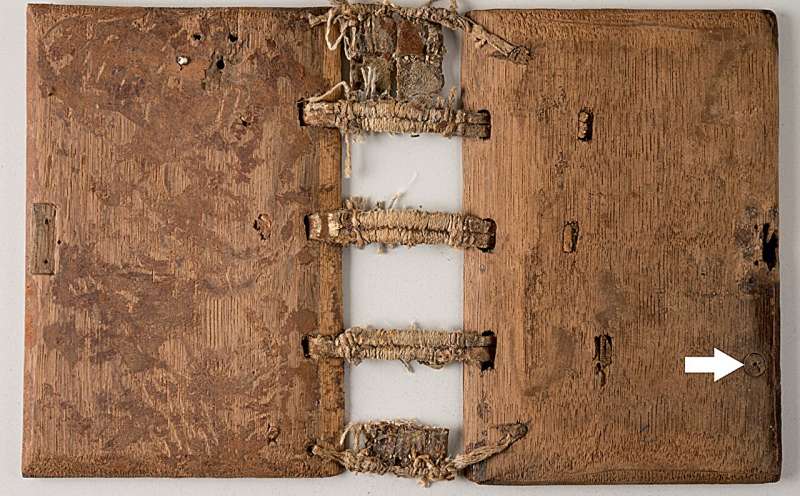Study Uncovers Origins of Estonia's Oldest Dated Manuscript: The Codex of Türi

April 6, 2025 feature
This article has been reviewed according to Science X's editorial process and policies. Editors have highlighted the following attributes while ensuring the content's credibility:
fact-checked
trusted source
proofread
by Sandee Oster , Phys.org
A recent study by Dr. Alar Läänelaid and his colleagues has provided new insights into the creation of the oldest dated manuscript in Estonia. The study published in the Journal of Cultural Heritage set out to determine the age and origin of the wooden covers used to bind the 15th-century codex.
The Gothic-style manuscript, bound by two oak boards, first came into the hands of conservators in 2021. The centuries-old manuscript, nicknamed the Codex of Türi, was completed in 1454 in the then-parish church village of Türi.
Soon after it was written, it made its way into the possession of the Dominican friary in Tallinn, as indicated by an inscription found in the manuscript reading 'Iste liber pertinet conuentui Reualiensi,' literally translating to 'This book belongs to the convent of Reualiens.'
The friary was dissolved in 1525 following the Lutheran Reformation in Tallinn, after which the codex fell into 'disuse' in the Tallinn archives.
The content of the Codex was, in essence, a Latin-German dictionary, says Dr. Kolk, one of the researchers involved in the study, 'Basically, it is a dictionary for a learned user. The main text, Vocabularius Ex quo, translates Latin words and expressions into Low German or occasionally just explains them in Latin with other words.
'Its focus is on Biblical language, but it also includes a wide range of other topics. A few pages at the end contain another verse Latin-German dictionary, a popular Middle-Ages genre to help memorize the contents. Both dictionaries were among the most widespread in the late medieval German-speaking area.'
'We do not know much about the manuscript's users. Its writer, who inscribed his name inside the book, may have been a priest in a rural parish or some other cleric active in the area who clearly needed the book to understand better the Vulgate Bible and perhaps other Latin texts.
'Later, the codex belonged to the Dominican friary's chained library, so it was meant for the friars' collective use. However, the users have not left considerable traces of their use inside the book. Not long after, in 1525, the convent was dissolved during the Reformation, and since then, the codex has been 'disused' in Tallinn's archives.'
While examining the wooden covers of the Codex, it was noted that the front panel had a non-functional round hole, which had been repaired with a wooden plug. The hole was a remnant of the earlier usage of the wooden board, indicating that the front cover, at least, had originally served a different purpose.
Few studies have focused on the dating and provenance of wooden book covers. Dr. Kolk says, 'The question has hardly ever been studied. Of course, the most obvious reason is that often, the wooden inside of the covers is not accessible for dendrochronological research [the study of tree rings] if the covers are in intact condition. Yet I also suspect that in most instances, the question has not attracted the researchers' attention at all.'
Dr. Kolk continues, elaborating on the methods used in the study, 'Since the manuscript was taken in pieces for conservation, we looked for various available means to study its materials, though without much budget to use.
'Dendrochronology combined with Strontium isotope analysis appeared suitable for provenancing and dating the boards. Additionally, it looked like an excellent occasion to test the combined use of both methods at a theoretical level and possibly qualify the results of one analysis with the help of the other. Earlier, this kind of combined research had been conducted for construction wood on a few occasions.'
Discover the latest in science, tech, and space with over 100,000 subscribers who rely on Phys.org for daily insights. Sign up for our free newsletter and get updates on breakthroughs, innovations, and research that matter—daily or weekly.
Using both dendrochronology and strontium isotope analysis, the researchers were able to date and determine the geological origin of the trees.
The back cover, which preserved 120 tree rings and nine sapwood rings, revealed the tree from which the board had been made was likely felled between 1454 and 1466. Taking into account the time it takes to season (dry and age) fresh wood and the inscription in the back of the book indicating the date on which the manuscript was completed, the back cover was likely made from a tree felled in 1454.
Both dendrochronology and Sr isotope analysis indicated that it had likely been sourced in Lithuania between Riga and Klaipėda.
The front cover, however, had been sourced from a tree felled at least 88 years prior to the manuscripts' completion, circa 1366. Sourced from an oak tree likely grown in Poland, around the confluence of the Bug and Narew Rivers.
According to Dr. Kolk, 'The carpenter (or the bookbinder) just had these pieces of wood available in his workshop.'
'Recycling was extremely common, at least in a slightly different area of bookbinding—using old parchment manuscript leaves for reinforcement or a 'buffer' between the wooden boards and the paper inside of the codex—also in this manuscript … there are many other instances: when a book was discarded, but its covers could fit for another book, they were reused.'
It is likely the hole seen in the front cover, which had been repaired using a wooden plug, are the remnants of the wooden board's original use before being repurposed as a book cover.
Precisely what this original piece of wood was used for is unclear.
'Right now, we have no plans for further study in this area. But I hope to return to studying book cover materials at some point in the future. Still, Alar and his dendrochronologist colleagues have other ongoing research on historical wood provenancing,' says Dr. Kolk.
More information: Alar Läänelaid et al, New evidence of re-use of an oak panel in Estonia: Covers of the fifteenth century Codex of Türi, Journal of Cultural Heritage (2025). DOI: 10.1016/j.culher.2025.02.015
© 2025 Science X Network




